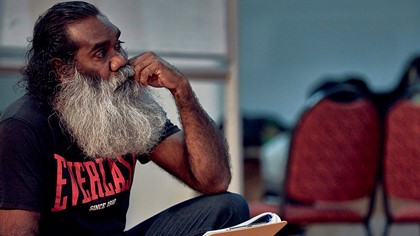Field Notes: Some Reflections On First Nations Dramaturgy
Posted Nov 19, 2020
Resident Artist Kamarra Bell-Wykes breaks down some of the key considerations that come into play when telling First Nations stories, and the power that comes with sharing that responsibility.
First Nations dramaturgy, like all artistic and cultural practices is not a fixed entity but something that evolves and adapts over time according to the context it occurs in and the people involved. Due to the diverse but shared collective experience of First Nations history, culture, political and social people, the broader backdrop that frames any First Nations work is at the core of this practice. The nuts, bolts, skills, tools, theory, technical knowledge and application are a vital part of First Nations dramaturgy but there are many other complex layers of interrogation and application that must be considered.
In an attempt to articulate this concept for myself in practical terms, my thoughts have started to gather in a growing framework that applies to not just dramaturgy but to all of my artistic practices. This is by no means a finite list and as each could have its own dedicated article I’ve settled on broad titles and dot-point summaries to encompass these various complex and evolving concepts:
Trauma-informed, relationship centred, spiritually safe
- Consciousness facilitation of a safe space for artists to develop and nurture artistic practice
- Practical accommodation of multi-layered needs and manifestations of Colonial violence and resilience
- An intentional awareness of the triggering and healing capabilities of a story and its impact on artists and audience
- Safely fostering and maintaining the multiple dynamics of respectful relationships and artistic roles
- If we can’t spend time together we probably shouldn’t make art together
Active, instinctual, culturally informed and responsive practice
- What approaches does the artist utilise/respond to/need?
- What cultural permissions, approaches, and knowledge are appropriate and who has the authority to include them?
- How do technical skills and instinctual compulsions interact and support the work?
- How are you engaging in a process of reflection and response, ensuring artistic and cultural integrity?
Collective and individual obligation and accountability awareness
- What is the story?
- Why are you telling it?
- Who does it belong to?
- Are we the best/right person to tell it?
- How does the story want/need to be told?
- Who is financially benefiting?
Narrative contribution to the cultural and political context
- What contribution are you making to the overall trajectory of the First Nations narrative and representation of First Nations people in mainstream and marginalised Australia?
- Is the work harming or helping?
- Who are you representing? How and why?
- Are you keeping yourself/community/culture safe?
- Are you challenging stereotypes or reinforcing them?
- Are you honouring artistic/cultural/political integrity?
- Are you achieving what you intended to?
First Nations art ultimately is an expression and application of who we are.
An embodiment of our individual and collective First Nation identities and is determined by the person/group practicing it. First Nations people are innately engaged in a process of interrogation. The way we represent, communicate, interact, conduct ourselves and each other as Aboriginal people and our contribution to the collective, and we apply this life approach to our artistic practice with equal if not more vigour. This essential artistic integrity is driven by our family, community and cultural accountability, the stakes in representing a marginalised minority on a public platform are incredibly high.
As an artist, I need to be able to ensure the above criteria and approaches are appropriately answered and achieved to safely and confidently engage in mine or anyone else's practice. Although the responsibility of care that comes with these types of considerations can seem daunting and overwhelming, time and time again, I find the deep richness of process and content developed within this type of framework is both provocative and rewarding, creating a space and ways of working that support both best possible practice and best possible artistic outcome.
Kamarra Bell-Wykes is a Yagera and Butchulla playwright, director, dramaturge, devisor, facilitator, performer, producer and education consultant. She first worked with Malthouse Theatre in 2003 through the Blak Inside program, and is best known for her work as Education Manager and Creative Director at ILBIJERRI Theatre Company. She is a Resident Artist at Malthouse Theatre.
